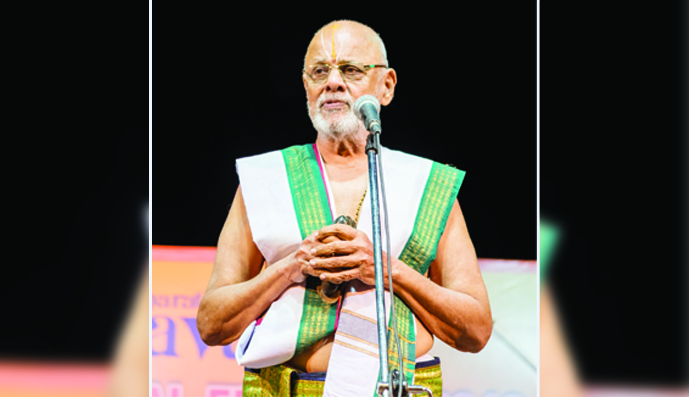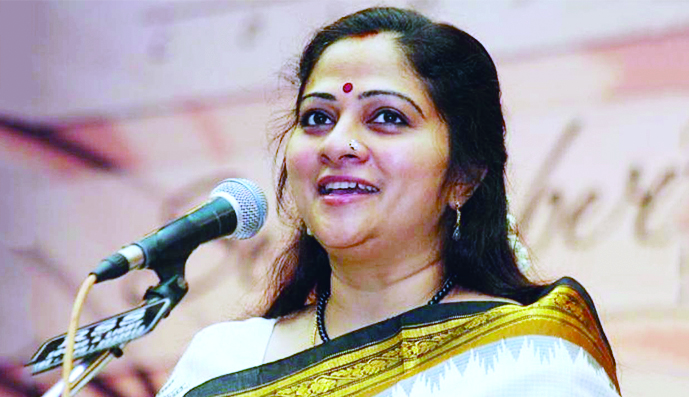Kalyanapuram Aravamudachariar, doyen of Harikatha—the ancient art of storytelling—is being honoured with the title ‘Nadhabrahmam’ by Narada Gana Sabha, Chennai, on 13 December 2019. Aravamudachariar, who has been successfully performing Harikatha for the past 40 years, considers this recognition as the “aseervadam” or blessings of his gurus Embar Vijayaraghavachariar and Tirukudanthai Andavan Swamigal. The famous Harikatha exponent, Embar Vijayaraghavachariar, was awarded the title of Sangita Kalanidhi in 1982 by The Music Academy, which can be considered as a milestone in the history of this art form. (See Sruti 83). Harikatha involves narration of a story with cross-references, intermingled with related songs and interesting anecdotes, making it different from pravachanam and upanyasam. Harikatha is called Narada peetham and upanyasam as Vyasa peetham. The Harikatha artist, with chiplas (cymbals) in hand to keep the beat, would be standing throughout the performance assisted by a vocalist, violinist and mridangist seated behind him on a raised platform.
S. Sowmya is a rare combination of an accomplished Carnatic vocalist, vainika, music scholar, and a brilliant academician. After her initiation into music by her father M. Srinivasan, and tutelage with doyens like Prof. S. Ramanathan (see Sruti 394) and T. Muktha (see Sruti 312), she earned her Ph.D degree from the University of Madras in 2012, for her research on enhancing the tonal stability of the mridangam, a work that combined music and science. Holding Master’s degrees in both Indian Music and Chemistry, she was a top-ranked scholar at the Indian Institute of Technology, Madras (IIT-M) and the University of Madras. Musically, she is a traditionalist to the core with a progressive outlook. Her repertoire is vast comprising several rare compositions. A widely travelled, popular and respected musician, Sowmya is the recipient of several prizes, titles and awards. The latest jewel in her tiara is the prestigious title of Sangita Kalanidhi which will be conferred on her at the sadas of the Madras Music Academy on 1 January 2020. She is the second-youngest woman to get the Sangita Kalanidhi, which comes to her as a golden jubilee gift (M.L. Vasanthakumari received the title at 49).
Arati N. Rao is an academician and musicologist with a passion for research into the historical development of Indian music. She is currently Assistant Professor, Coordinator - Music, Department of Performing Arts, and research guide at JAIN (deemed-to-be) University, Bengaluru. Arati was born in September 1971 to Manjula and N.A.P.S. Rao in Bengaluru. Her mother, a student of Prof. G. Chennamma (veteran Carnatic music teacher in Bengaluru) was keen that her daughter be trained in that genre of music. As Rao was working with the Indian Railways, the family kept moving from one place to another. Consequently, Arati learnt vocal music and veena from Sethulakshmi Vishwanathan at Lucknow, Kamala Swamy at Nagpur, R.K. Srinivasa Murthy and R.K. Prakash (sons of R.S. Keshavamurthy) and E.P. Alamelu in Bengaluru. She also later learnt vocal music from Sukanya Prabhakar and continues to learn the veena from Revathi Sadasivam.
Carnatic music has been evolving, probably, from the time it took its roots in south India. The evolution involves forms of compositions, usage of ragas, introduction of new ragas, themes of compositions, concerts, formats, duration, emphasis and more. Vocal and instrumental music have coexisted and have enjoyed varying degrees of patronage from the listening public (“languished for want of patronage” may be more appropriate in some cases!). Nagaswaram and tavil, veena, flute, gottuvadyam (now rechristened chitraveena), mridangam, ghatam and khanjira were among the traditional instruments. Over time, other instruments were introduced to the music with varying degrees of success. The violin remains the strongest entrant—it was amenable to the production of most of the gamakas; the bow helped sustain notes for a long duration; it was seamlessly adopted as an accompanying instrument for all vocal concerts, for most flute concerts and for a few other instruments, too.
CONTENTS
6 News & Notes
14 Birthday calendar
16 Kalyanapuram Aravamudachariar
28 S. Sowmya
40 Season 2019-20
v Come December— its ‘season time’ in
Chennai
v Titles and awards
v Interview: Arati Rao
58 Heritage v The season, 75 years ago
68 Point of view v Applause
in the Indian context
72 Spotlight v The status of C-instrumental music
today
80 Tribute v Ramakant Gundecha
82 News & Notes (continued)
84 Wellness v Yoga for dancers
86 Analysis v The maha melaragamalika (part 3)
94 From the Editor
Front
Cover: S. Sowmya (photo
by Ramanathan N. Iyer)
Kalyanapuram Aravamudachariar (photo
by Hemamalini S.)
No.
423






